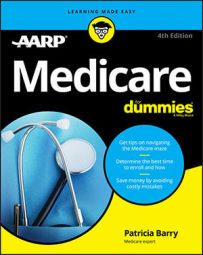Parts A and B are also the basis of your coverage if you’re in a Medicare Advantage health plan, because all those plans must by law cover the same services as the traditional program, although the plans can provide extra benefits if they want to.
 © Vitalii Vodolazskyi /Shutterstock.com
© Vitalii Vodolazskyi /Shutterstock.comThese two parts of Medicare cover entirely different services. But sometimes Parts A and B work in tandem. For example, if you need to go into the hospital, in most cases Part A covers the cost of your room, meals, and nursing care after you’ve met the deductible.
But Part B covers the cost of your medical treatment — services provided by surgeons, other doctors, and anesthetists. This division of coverage also applies to staying in a skilled nursing facility for continuing care after leaving the hospital, using home health services, and receiving hospice care.
Necessary medical care
In essence, Medicare covers services that are reasonable or necessary to save life and maintain or improve health. That includes really big-ticket items — such as transplants of the heart and other organs, delicate surgery to repair severe injuries, cancer treatments, and many others — that cost Medicare tens of thousands, and in some cases hundreds of thousands, of dollars.The program also, of course, covers more-routine and less-expensive services, from allergy shots to X-rays.
No doubt about it: Medicare can split hairs. It may cover a service in some circumstances but not others. One glaring example of this discrepancy is that Medicare covers power-operated vehicles, such as scooters and manual wheelchairs (as opposed to the conventional type) only if you need one to get around inside your home but not if you need one just to be mobile outdoors. In 2018, Medicare began requiring prior authorization for the coverage of certain types of power wheelchairs (33 in all) before Medicare will cover the cost. Medicare may also cover a treatment in some parts of the country but not everywhere. But on the whole, Medicare pays for a vast range of medical services that people need.
Sometimes people who’ve used a lot of services, or a few really expensive ones, and are scared to death that their Medicare coverage is going to “run out.” This isn’t something to worry about. In general, no limit caps the amount of coverage you can get from Medicare for necessary services — except for a few specific situations.
Preventive care
Being able to treat a medical problem is good, but dodging it altogether is better! These days, that seems an obvious truth. Yet Medicare has only fairly recently expanded coverage for services that help prevent or stave off some of the diseases that make people very ill and — not coincidentally — cost Medicare mountains of money.Even better: Many of these preventive tests, screenings, and counseling sessions now come free (no co-pays or deductibles) thanks to the 2010 Affordable Care Act. As of 2020, some 44 million people with Medicare took advantage of these services, at no cost to themselves, according to government reports.
But to get these services for free, know that you need to see a doctor who accepts assignment — meaning that she has agreed to accept the Medicare-approved amount as full payment for any service provided to a Medicare patient. Otherwise, you have to pony up a co-pay or, in some circumstances, even the full cost.
Now take a look at this table, which shows the range of preventive tests, screenings, and counseling sessions that Medicare covers under Part B and whether they cost you anything. It’s a pretty impressive list!| Service | Frequency Covered | Cost to You |
| “Welcome to Medicare” checkup | Once only, during first 12 months in Part B. | Free, but any other tests the doctor refers you for may require a co-pay. |
| Wellness checkup | Once every 12 months, after you’ve had Part B for one year. | Free as long as you ask for a wellness visit and not a “physical.” |
| Abdominal aortic aneurysm screening | One-time ultrasound for people at risk. | Free. |
| Alcohol misuse screening and counseling | One screening and up to four counseling sessions a year. | Free. |
| Bone mass measurements | Once a year if you’re at risk for broken bones; more if medically necessary. | Free. |
| Breast cancer screening (mammograms) | Once a year for women age 40 or older. | Free. |
| Cardiovascular disease (behavioral therapy) | Once a year. | Free. |
| Cardiovascular disease screening | Once every five years. | Free for the tests, but a co-pay is usually required for the doctor visit. |
| Cervical/vaginal cancer screening | Once every 24 months, or every 12 months if you’re at high risk. | Free. |
| Colorectal cancer screening — barium enema (when used instead of flexible sigmoidoscopy or colonoscopy) | Once every 48 months, or every 24 months if at high risk. | A co-pay is required. |
| Colorectal cancer screening — colonoscopy | Once every 120 months, or every 24 months if at high risk. | Free for the test, but a co-pay is required if a polyp is found and removed during the test. |
| Colorectal cancer screening — fecal occult blood test | Once every 12 months if you’re 50 or older. | Free. |
| Colorectal cancer screening — flexible sigmoidoscopy | Once every 48 months if you’re 50 or older. | Free. |
| Depression screening | Once a year in a primary-care setting. | Free screening, but a co-pay is required for doctor visit and follow-up care. |
| Diabetes training | Training on how to self-manage diabetes — up to 12 hours in the first year and up to two hours every year after that. | A co-pay is required, and your Part B deductible applies. |
| Diabetes screening | Up to two screenings a year if you’re at risk of developing diabetes. | Free. |
| Flu shots | Once a year in flu season. | Free. |
| Glaucoma (eye disease) tests | Once every 12 months if you’re at high risk. | A co-pay is required, and your Part B deductible applies. |
| Hepatitis B virus (HPV) infection screening | Annually only for those considered at risk who don’t get a Hepatitis B vaccination. | Free. |
| Hepatitis C screening test | One-time screening; yearly screening for people at high risk or those born between 1945 and 1965. | Free. |
| HIV screenings | Once every 12 months or up to three times during pregnancy. | Free. |
| Lung cancer screening | Once a year for people age 55–77, who are current or former smokers averaging one pack a day for 30 years, but without symptoms of lung disease. | Free. |
| Obesity screening and counseling | Behavioral counseling sessions if your body mass index (BMI) is 30 or higher. | Free. |
| Pneumococcal shot | After age 65, one type of shot followed at least one year later by a second shot. | Free. |
| Prostate cancer digital rectal exam | Once every 12 months for men over 50. | A co-pay is required, and the Part B deductible applies. |
| Prostate cancer PSA test | Once every 12 months for men over 50. | Free. |
| Sexually transmitted infections screenings and counseling | Tests once every 12 months or more often if pregnant. Up to two counseling sessions with a primary-care provider. | Free if tests are ordered by a doctor and performed in a Medicare-approved laboratory. |
| Smoking and tobacco use cessation counseling | Up to eight sessions in any 12-month period. | Free. |
| X-rays, MRIs, CT scans, EKGs, and so on | As ordered for diagnosis by a doctor. | A co-pay is required, and your Part B deductible applies. |
Note: Services labeled “free” (meaning no co-pay or deductible required) assume that you go to a doctor who accepts Medicare’s payment in full.
Specialized Care in Certain Circumstances
Medicare Part A is usually associated with care within the hospital, of course. But it also covers certain specialized services outside the hospital, most of which focus on nursing. Part B, too, covers some types of specialized care, such as physical therapy.- Care in a skilled nursing facility
- Home health-care services
- Hospice care
- Palliative care
- End-of-life care counseling
- Pregnancy and childbirth

